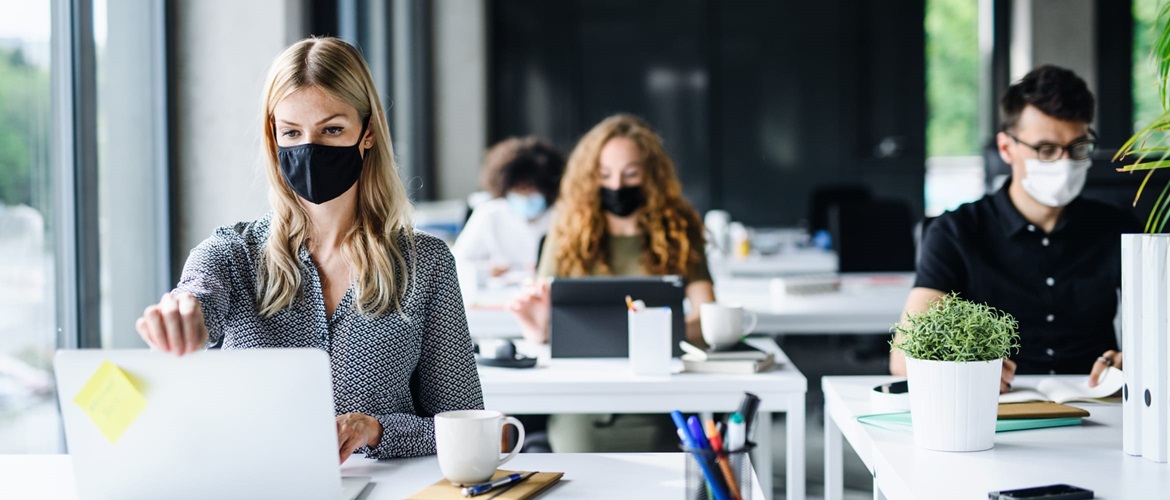
Back to work? Ensuring working safety during and after lockdown
As businesses of all kinds react to the new and evolving local tiering system, it is vital that any colleagues still on site are kept safe, while remaining as productive as possible.
The first port of call for any business maintaining a colleague presence is the effective and clear communication of the fundamental changes to working practices.
The Government has published specific guidelines for different kinds of workplaces, from offices to shops and restaurants, but as the situation continues to evolve so too do the guidelines.
What is certainly true of most businesses is that space restrictions mean it might not be possible to welcome all colleagues back to work and still maintain social distancing. Therefore, many organisations are dealing with the prospect of a hybrid workforce, spread across home working and office environments.
In the office
Can IT reduce the risk for those in the office?
While current restrictions are certainly making remote working preferable for most, many businesses are eager to have, and indeed require, staff back in the workplace.
Where this is the case, good IT practices can be an important aspect of the package of measures needed to reduce the risk of the virus being spread.
We know that one of the ways that Covid-19 can be transmitted is through people touching surfaces that have been contaminated with the virus.
Many offices have a single multifunction printer, shared by numerous people every day, which can present an opportunity for this to happen.
So, it’s worth seriously considering touch-free printing solutions that allow users to release print jobs contactlessly, using their smartphone or an NFC card, without having to enter a pin code on a number pad.
Another option is to switch to decentralised printing, where a greater number of smaller printers are shared by fixed teams who work together, limiting the number of people each person has indirect contact with.
To this end, hotdesking should also be put on hold and workstations should be arranged back-to-back or side-to-side whenever possible, rather than face-to-face, to maintain social distancing.
Empowering facilities management teams to get the message across
Signage and labelling are fundamental to any Covid-safe workplace and firms will want to consider clarity, durability and size.
Professional-looking guidance will have to be displayed prominently at the entrance to your premises and all around the building.
You’ll be printing both temporary and more permanent custom signage, so you’ll need a print solution that’s capable of creating a variety of label sizes, applications and levels of durability.
That will mean printing on paper and laminated media, which is resistant to wear, water and chemicals like antibacterial cleaners.
Think about the need to signpost one-way traffic through the workplace - particularly at potential pinch points like staircases and corridors - and mark out areas on the floor to help people keep their distance from one another.
It’s likely you’ll have to update existing signage too, like maximum occupancy signs in lifts, as well as amending your new messages in line with changing guidelines.
If you want to read more about labelling for a safe return to work, you can do so here. Our free toolkit of signage templates is also available to download, including a range of social distancing stickers to download and print instantly from our label printers.
Working from home
Keeping colleagues safe and supported whilst working from home
Colleagues working from home have had to quickly adapt to using technologies like video conferencing and document sharing platforms as standard.
But being away from the office, and the normal security protection provided by their employer, also makes them more vulnerable to cyberattacks.
Unfortunately, hackers have learnt that modern printers with advanced features like the ability to receive jobs by email or scan hard documents direct to the cloud, can be a point of attack.
A solution to this is to implement a cloud-based managed print service (MPS) to provide a safe, efficient remote working solution for print fleets, including everything from installation and tech support to a tailored security plan including regular upgrades.
Outside of technology, another potential pitfall of long-term home working is that colleagues can become isolated, so it’s important they feel supported and that their physical and mental wellbeing is being looked after.
You can read more about the communication principles that will make your remote workforce happier here.
Home working is here to stay
Remote working was already a growing trend among British businesses, but it has rapidly accelerated during the coronavirus outbreak; half of us worked from home during April 20201, compared with just over five per cent during 20192.
Firms can continue to help colleagues to work from home by making sure they have the reliable and connected technology they need to be productive.
Brother research found that 69% of British businesses say staff could work at home more productively with better tools, and when the business agenda shifts from firefighting to planning for a sustainable recovery, 85% plan to invest in tech to improve this in the next year.
Document sharing platforms and digital tools like electronic signatures can help maintain business continuity and the rapid upturn in video conferencing – Zoom went from 659,000 users in January to 13 million in April – proves its ongoing value.
Lasting change?
We’ve seen that the world of work has changed drastically in the last few months.
How permanent some of these changes will be remains to be seen, but whatever comes our way next, it’s up to all employers to make sure their staff are protected and productive.
Within this piece we’ve referenced and linked to a number of our solutions, products and features that can benefit organisations challenged by making their premises safe and ensuring remote working productivity and safety for their colleagues.
To find out more use the links below:
- Touch-free printing with Brother's Secure Print+
- Cloud managed print services
- Covid-19 labelling and signage solutions



